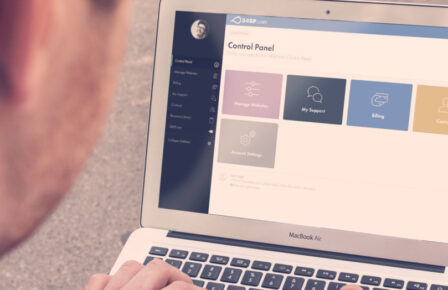WordPress Multisite is a brilliant tool if you need to manage multiple sites under one roof. It can cut down on maintenance time and streamline updates. But when it comes to SEO, things get a little more complicated…
While a Multisite setup can help centralise SEO efforts, it also introduces a few technical hurdles. This can include handling duplicate content, structuring URLs correctly, and making sure your networked sites aren’t slowing each other down. If you’re running a network of related sites, Multisite might be a perfect fit. However, if you need each site to have a completely different SEO strategy, you could run into some roadblocks. So, is WordPress Multisite good for SEO? The answer, like most things in SEO, is “it depends.”
We’re here to break down the advantages, the challenges, and a decision-making checklist to make sure your Multisite set-up can help not hinder your organic visibility. Plus, we’ve gathered insights from SEO experts who’ve worked with WordPress Multisite first-hand!
If you’re not yet familiar with how WordPress Multisite works, check out our WordPress Multisite Guide. It covers everything from installation to use cases, as well as when Multisite might not be the right choice for your website.
How Multisite can help with SEO
When used correctly, a WordPress Multisite setup can make SEO management easier, especially for businesses running multiple related websites.
You can manage SEO in one place (and save time)
One of the biggest benefits of Multisite is the ability to manage all websites from a single dashboard. This means SEO settings, plugin updates, and site structure changes can be made across multiple sites at once, ensuring consistency and saving time. This can lead to improved technical SEO by reducing errors, ensuring consistency, and making it easier to apply improvements across multiple sites.
Elad Maoz, CMO at Gifted.co, explains:
“The biggest advantage of Multisite is centralised management. If you’re handling multiple sites under the same brand or niche, it allows you to streamline updates and plugin installations while maintaining a cohesive structure. This consistency can positively impact your SEO, as you’re less likely to overlook technical updates that affect performance.”
Dhanvin Sriram, founder of Luppa AI, highlights:
“Multisite makes it easy to roll out changes, optimise settings, and ensure consistency across the board. This can lead to better technical SEO, like faster page speeds and fewer errors.”
Example: A retail business with multiple regional stores could update product descriptions across all sites at once, ensuring consistent messaging and avoiding duplication of effort with manual updates for each website.
It’s great for multi-location or multilingual SEO
Do you need different versions of your website for other countries, languages, or regions? A Multisite setup can make it easier to structure them correctly and help Google understand which site should rank in each location.
Ashot Nanayan, founder and CEO of DWI, adds:
“The main advantage to Multisite is the central management of several sites, which will simplify workflows and reduce overhead, thus maintaining consistency across different regions or product lines. If your business has diverse geographical or language-specific needs it needs to attend to, Multisite enables you to create localised domains that are serving particular audiences better and will be easier to scale and optimise for international SEO.”
Example: A travel agency operating in the UK, Spain and Germany could use Multisite to create country-specific sites with localised content while keeping the same core branding and structure.
It allows structured experimentation across multiple websites
One of the lesser-known advantages of WordPress Multisite is its ability to facilitate controlled SEO testing. Instead of applying changes across all sites at once, businesses can experiment with new structured data, page layouts, or internal linking strategies on a subset of sites before rolling it out network-wide.
Aljay Ambos, Head of SEO at Twixify, explains:
“WordPress Multisite allows you to experiment across multiple sites in a controlled fashion. For example, if you want to see how adding a specific structured data type affects rankings in different niches, you can apply the changes to just a few subsites without affecting the rest. This makes it easier to test and learn without risking the performance of your entire network.
Example: A digital publishing network that runs multiple news websites could test whether adding FAQ schema improves rankings on just one category (e.g., finance news) before expanding the change to other categories like politics, technology, or sports.
Centralised security benefits SEO indirectly
Security is often overlooked when considering SEO, but a hacked or compromised website can suffer significant ranking penalties if search engines detect malware or spammy content. A risk of WordPress Multisite is that a security breach on one site can spread across the entire network. However, when managed correctly, Multisite can offer better security monitoring and response times.
Firdaus Sateem, Founder of VoidSEO, highlights this risk and the importance of regular monitoring:
“WordPress Multisite, if configured correctly, is good for SEO. But if one of the sites is infected by malware, it could potentially harm and dramatically reduce the SEO performance for all sites. Another thing that will affect SEO is if your other site gets backlinks from black-hat tactics and spammy sites, which will affect Domain Authority score since they are shared among the sites. It will be time-consuming to audit all the sites and recover them one by one.”
Example: A franchise business running 50+ location-based websites under a Multisite setup can monitor threats and issues from one control panel. This setup allows site admins to detect and remove malware before search engines blacklist any part of the network, protecting rankings across all locations.
Why WordPress Multisite can hurt SEO efforts
You might run into duplicate content issues
If multiple sites in your network share similar content, Google may struggle to decide which one should rank. This can lead to lower visibility across all sites.
Sai Deshmukh, SEO director at Amber, warns:
“Issues like duplicate content across subdomains and inconsistent hreflang implementation led to temporary ranking drops for a regional e-commerce business I worked with.”
Sandy Meier, head of marketing at Contentellect, adds:
“It also depends on your content differentiation. If you’re running truly distinct properties, say separate regional versions of an e-commerce site with unique products and content, then Multisite can work for you, however, sharing templates or similar content across sites more often than not triggers search engine penalties.”
Example: An e-commerce site that operates in both France and Belgium might set up two French-language versions of the site—one at /fr for France and another at /fr-be for Belgium. Since both versions are in French and have similar content, search engines may struggle to determine which one should rank, even if hreflang tags are correctly implemented. This could lead to Google indexing only one version, potentially reducing visibility for the other country.
You need to decide between subdomains vs. subdirectories
One of the biggest decisions in a Multisite setup is whether to use subdomains (e.g., blog.yoursite.com) or subdirectories (e.g., yoursite.com/blog).
Google treats subdomains as separate websites, meaning you’ll have to build authority for each one individually.
Firdaus Sateem, (VoidSEO), explains:
“Google treats subdomains as different websites. This can be beneficial if your main domain has a high domain score, but it also means backlinks are not always shared effectively between subsites.”
Example: A legal firm using subdomains for different practice areas (familylaw.yourfirm.com and corporatelaw.yourfirm.com) may struggle with link building, as Google treats each subdomain as a separate website. This means backlinks earned by one subdomain don’t benefit the others, making it harder to build domain authority. As a result, each subdomain requires its own SEO efforts, which can dilute link-building efforts for each site.
One slow site can slow down everything
Since all sites in a Multisite network share the same hosting resources, one slow-loading site can impact the performance of the entire network.
Ashot Nanayan, (DWI)
“One of the big downsides to Multisite is that every site on that network shares server resources, and if one experiences performance issues or a technical problem, it could cascade across all other sites, eventually leading to a loss in rankings”
Example: An online magazine using Multisite to manage different topic-based sections (e.g., fashion, sports, tech) might struggle with slow performance if one section experiences high traffic or uses inefficient plugins.
Tracking performance can be tricky
One major downside of WordPress Multisite is that tracking SEO performance and user behaviour across multiple sites requires extra configuration. Unlike standalone WordPress installations, where analytics tools can be set up individually for each site, a Multisite network shares a single WordPress dashboard, making it harder to separate data for each subsite.
That isn’t to say that there are no workarounds. Some analytics platforms allow you to add multiple data streams or properties so each site can be tracked individually alongside being aggregated into a single view.
Dhanvin Sriram (Luppa AI) points out:
“Separating traffic and performance data for individual sites can be tricky, making it harder to optimise effectively.”
Example: A multi-location healthcare provider using Multisite for its different clinics (e.g., yourhealthclinic.com/london, yourhealthclinic.com/manchester) may find it difficult to track organic traffic, bounce rates, and conversions per location.
So, is multi-site right for your SEO goals?
Multisite is a good fit if
✅ You have multiple sites that share branding, structure, or content
✅ You’re managing regional or multilingual sites
✅ You want to reduce admin work and manage everything in one place
Multisite is not ideal if
❌ Each site needs a completely different SEO strategy
❌ Your sites are in different industries or target very different audiences
❌ You need unique plugins and themes for each website
Sheraz Ali, founder of HARO Link Building Agency, sums up how to approach your decision to go with Multisite. The success of the set-up depends on how well it aligns with your unique goals and the context the websites are operating in.
“Having managed more than 50 WordPress Multisite installations, I can confirm that the right implementation is key to SEO success. On average, my clients save 40% of the time spent on maintenance compared to when they were using separate WordPress installations. In one project in the education sector, we used Multisite to manage 15 departmental websites, which saw a 65% increase in organic traffic within six months”
If you’re considering Multisite for your website, check out our WordPress Multisite guide for more information on installation, configuration, and use cases.



